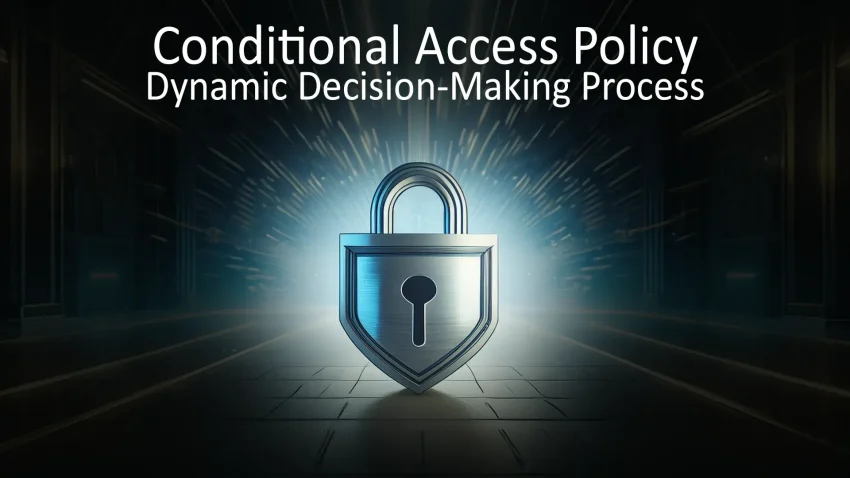Dynamic Conditional Access Policies are revolutionizing the way organizations manage access to their applications and resources. These advanced policies utilize custom security attributes to create a more flexible and efficient security framework, crucial in today’s complex IT environments. By tailoring access requirements based on individual application needs rather than imposing broad standards, businesses can minimize policy drift and enhance compliance. Moreover, this approach aligns with stringent MFA requirements, ensuring that security remains a top priority while adapting to evolving organizational demands. In this blog post, we will explore how Conditional Access implementation can streamline security policy management, optimizing user experiences and reinforcing organizational security.
Dynamic Conditional Access Policies, alternatively known as adaptive access controls, are key to addressing today’s cybersecurity challenges. This innovative framework leverages tailored security attributes, enabling organizations to implement nuanced access criteria that respond to specific user behaviors and risks. By shifting away from the rigid, one-size-fits-all policies of the past, businesses can ensure that their security measures are both effective and efficient, allowing for a balance between user accessibility and protection. The adaptability of these policies enhances overall security posture, aligning with the growing need for robust MFA requirements. Through effective security policy management, organizations can achieve a comprehensive approach that meets the demands of modern digital landscapes.
Understanding Dynamic Conditional Access Policies
Dynamic Conditional Access Policies offer organizations a flexible and efficient method to manage access to applications and resources. Unlike traditional Conditional Access policies, which often become overly complex and result in policy drift due to numerous custom requirements and exceptions, dynamic policies streamline the approach by allowing security attributes to function as a centralized control mechanism. This approach mitigates the need for excessive individual policies for each application, instead grouping applications by their risk profiles through custom security attributes.
By implementing dynamic Conditional Access policies, businesses can effectively enforce security protocols that resonate with their operational landscape. Custom attributes can be assigned to resources to clarify their security requirements, enabling tailored access controls based on individual application needs. As the landscape of cybersecurity continually evolves, utilizing these dynamic policies ensures organizations can adapt without compromising their security posture.
The Role of Custom Security Attributes in Access Management
Custom security attributes serve as vital components in the framework of Conditional Access policies, enhancing security management by allowing organizations to tag applications with specific access requirements. By categorizing resources with these attributes, businesses can employ more comprehensive security policies that reflect the unique characteristics and risk levels associated with each application. For instance, a Level 1 attribute may enforce stringent MFA requirements, while higher levels could introduce additional session controls and network restrictions.
This strategic approach not only simplifies security policy management but also allows application owners to tailor their security conditions without creating a convoluted web of Conditional Access policies. By utilizing fine-grained attributes, organizations can balance flexibility and security, ensuring that the appropriate access protocols apply depending on the context in which applications are accessed.
Implementing MFA Requirements Within Dynamic Policies
Multi-Factor Authentication (MFA) requirements are essential in safeguarding sensitive resources in a dynamic Conditional Access environment. By integrating MFA as a core component of the access management strategy, organizations can enhance security by requiring multiple verification methods before granting access. This is particularly critical in scenarios where applications have been assigned varying custom security attributes that dictate differing levels of authentication, thereby ensuring only authorized users can access sensitive systems.
Employing dynamic Conditional Access policies enables an organization to enforce MFA requirements consistently based on the assessed risk level of each application. As applications evolve, the ability to adapt these requirements dynamically ensures that security measures grow alongside the threats faced, thereby maintaining robust defense mechanisms against unauthorized access.
Conditional Access Implementation for Enhanced Security
Implementing Conditional Access policies efficiently is vital for effective security management. Organizations need to clearly define their security goals and assess the level of risk associated with different resources to establish a coherent set of guidelines. Dynamic technologies integrated into Conditional Access implementations can effectively evaluate user contexts, leveraging custom security attributes to determine appropriate access levels.
By utilizing these dynamic technologies, organizations can not only streamline their Conditional Access policies but also reduce the administrative burden associated with traditional policy management. The integration of adaptive controls ensures that when conditions change—such as user location or device compliance—the resultant adaptations reflect immediate shifts in security protocols. This agile approach to security policy management prepares organizations to proactively manage risks within their access frameworks.
Navigating Policy Drift in Conditional Access
Policy drift commonly occurs when organizations have too many overlapping Conditional Access policies, each with its own set of custom requirements. This drift can lead to a convoluted security landscape that risks exposure to vulnerabilities, making it crucial for organizations to adopt dynamic Conditional Access policies. By consolidating security attributes and leveraging a more straightforward categorization approach, organizations can maintain clarity and control over their access management.
Employing custom security attributes reduces the complexity typically seen in static policies by allowing for simple modifications and updates. As organizations expand their digital landscapes, the dynamic nature of access policies ensures they can effectively manage their security posture without the burden of misalignment that comes from having too many convoluted permissions and requirements.
Fine-Grained Control: A Step Towards Enhanced Security
Fine-grained control represents a crucial advancement in how Conditional Access policies are structured and implemented. This approach allows application owners the opportunity to clearly define multiple attributes for each application, resulting in tailored security measures that correspond directly to the specific contexts of use. Unlike more blunt methods that apply broad policies across vast categories, fine-grained control ensures precision in enforcement, reducing the risk of unauthorized access.
With fine-grained attributes in place, organizations can also ensure compliance with evolving security regulations. As companies adapt to new requirements or threats, the ability to adjust these attributes quickly and effectively ensures that security is not only adequate but proactive. Thus, fine-grained control forms a critical component of modern Conditional Access frameworks, aligning with best practices in security management.
The Importance of Security Policy Management
Effective security policy management is a cornerstone of any robust cybersecurity strategy. Organizations must regularly review and update their Conditional Access policies to address new threats, regulatory changes, and evolving business needs. Dynamic Conditional Access policies, bolstered by custom security attributes, allow for this ongoing management without a detrimental impact on user experience or overall security.
A proactive approach to security policy management actively incorporates feedback and changes from across the organization, ensuring that all aspects of access controls are aligned with current security best practices. Thus, not only does this approach keep risks at bay, but it also fosters a security-conscious culture within the organization.
Conclusion: The Future of Conditional Access Policies
The future of Conditional Access policies lies in their ability to adapt to the ever-changing threats in the cybersecurity landscape. By integrating dynamic Conditional Access policies with strategic implementations of custom security attributes, organizations can build a more flexible, responsive security environment. This evolution is critical as businesses grow and their operational needs shift.
As we continue to explore the potential of these methodologies, it becomes clear that effective management and implementation of Conditional Access policies are essential for ensuring the safety of organizational resources. Future discussions will delve deeper into technical implementations and best practices that will enhance the efficacy of dynamic Conditional Access strategies, paving the way for a safer and more secure digital experience.
Frequently Asked Questions
What are Dynamic Conditional Access Policies and how do they utilize custom security attributes?
Dynamic Conditional Access Policies are advanced security measures that adapt access requirements based on specific conditions or user contexts. They utilize custom security attributes, which act as tags assigned to applications and resources, allowing organizations to streamline the management of access controls without needing separate policies for each application.
How do custom security attributes enhance Conditional Access policies?
Custom security attributes help enhance Conditional Access policies by enabling organizations to define specific access requirements for applications based on risk levels. These attributes allow for aggregated controls or fine-grained settings that align access with security needs, thus improving security policy management.
What role do MFA requirements play in Dynamic Conditional Access Policies?
MFA requirements are critical components of Dynamic Conditional Access Policies, ensuring that access to applications and resources is secured by multi-factor authentication. By integrating MFA into Conditional Access policies, organizations can enforce stronger authentication based on custom security attributes linked to specific applications.
Can Dynamic Conditional Access Policies reduce the complexity of security policy management?
Yes, Dynamic Conditional Access Policies can significantly reduce complexity by consolidating multiple access controls into fewer policies, leveraging custom security attributes. This streamlined approach prevents policy drift and simplifies the implementation of Conditional Access policies across an organization.
How can organizations implement Conditional Access policies using custom security attributes?
Organizations can implement Conditional Access policies by tagging their applications and resources with custom security attributes. This allows them to define specific access requirements and associate those attributes with Conditional Access policies, ensuring that the correct security measures are enforced based on the assigned attributes.
What are the benefits of using aggregated controls in Dynamic Conditional Access Policies?
Using aggregated controls in Dynamic Conditional Access Policies allows organizations to enforce multiple security requirements through a single custom security attribute. This approach simplifies policy management and ensures that various access controls, such as compliant networks and sign-in frequencies, are consistently applied across resources.
What is fine-grained control in the context of Dynamic Conditional Access Policies?
Fine-grained control in Dynamic Conditional Access Policies refers to the ability to define and apply specific custom security attributes to applications in a detailed manner. This allows organizations to create tailored Conditional Access policies that meet unique security requirements for each application, enhancing overall security management.
How do conditional access implementation strategies impact security policy management?
Effective conditional access implementation strategies directly enhance security policy management by allowing organizations to establish clear, context-driven access controls. By using approaches like Dynamic Conditional Access Policies with custom security attributes, organizations can adapt their policies to changing risk profiles without the burden of excessive complexity.
Can Dynamic Conditional Access Policies be used for baseline security policies?
While Dynamic Conditional Access Policies are not intended for establishing baseline security policies, they can complement them. Organizations should first implement baseline policies that specify essential security measures, such as MFA, before leveraging dynamic policies to address more complex access scenarios.
| Key Point | Description |
|---|---|
| Dynamic Conditional Access Policies | A method to manage access requirements flexibly without creating multiple policies for each application. |
| Custom Security Attributes | Tags assigned to applications/resources to define specific access requirements. |
| Approach 1: Aggregated Controls | Combines several controls into one attribute, making it easier to enforce multiple access requirements. |
| Approach 2: Fine-Grained Attributes | Allows application owners to apply specific, separate security attributes for greater flexibility. |
| Baseline Policies | These are essential foundation policies that ensure strong access control across all resources. |
Summary
Dynamic Conditional Access Policies are crucial in managing application and resource access requirements in a flexible and efficient manner. By utilizing Custom Security Attributes, organizations can simplify policy management and enhance security without overwhelming their systems with numerous policies. This approach not only helps to reduce the complexity often associated with Conditional Access policies but also offers the adaptability needed to meet specific security standards. Whether through Aggregated Controls or Fine-Grained Attributes, Dynamic Conditional Access Policies empower businesses to maintain robust security while efficiently managing access controls.








